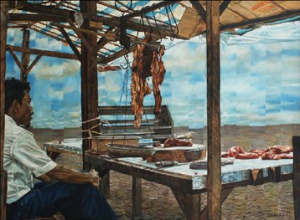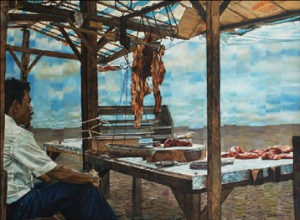[slideshow]
A Heart for Textiles: The Late Tuti Pandjaitan
Traditional Indonesian textiles is famous for their beauty as well as their cultural value. Those originating from the Lesser Sunda Islands particularly intrigued the late Catharina Dwiastuti “Tuti” Pandjaitan (1958-2010), the wife of the Udayana Military District Commander, Hotmangaradja Pandjaitan. She often joined her husband when he visited the remote areas of the military district of his command, which encompassed the islands of East and West Nusa Tenggara and also Bali. While her husband fulfilled his military duties, Tuti engaged in her own mission, which turned out to be humanitarian and cultural in nature.
Since 1988, Tuti had been diagnosed with an incurable heart condition. However, it seems that her health has never become an obstacle in her activities. To the contrary, it is apparent that instead it has motivated her to do more, and to be more and more useful to others. In honor of her mother-in-law, the widow of DI Panjaitan, one of the military high officials assasinated during the 1965 Coup attempt, Tuti set up the Yayasan Cita Abdi Bangsa foundation. Through this foundation, she channeled her humanitarian and cultural activities, particularly in health care and education. In collaboration with musicians and artists, Tuti created children’s songs to evoke a renewed interest in music.
On her visits accompanying her husband to remote areas, she often found that the textile tradition was facing a crisis due to the lack of basic infrastructure. At first she would bring supplies of thread and other materials for the weavers.
During a visit to one village, she learnt that some of the colors that were used in old textiles produced in that village, was no longer produced due to lack of water. Due to the scarcity, any available water was used to fulfill basic needs first. Therefore, producing the old colors was not a priority.
When Tuti learnt that the old colors to be produced again if a well could be built in the village, she immediately provided the means to have the well constructed. Now, the village is continuing to produce textiles with the old traditional colors once again, thanks to the well. Known as the “Tupa” (an abbreviation for Tuti Pandjaitan) well, today it not only revitalized the textile industry in the village, but also provides water for the basic needs of the villagers. She soon realized that the villagers needed to be self-sufficient.
As she tried to make the villagers to be self-sufficient, Tuti also realized that the production of textiles still needed patronage and support as well as marketing and promotion. Therefore, she started to build a collection of textiles from the region, and encouraged her friends and acquaintances to also develop their collections.
Part of her collection will be auctioned at the commemoration of her passing away to raise funds for the Yayasan Cita Abdi Bangsa this Friday, 21 October 2011, to enable her efforts in providing support for the textile weavers, especially those living in remote areas of East and West Nusa Tenggara, to be continued. The late Tuti Pandjaitan had developed a heart for textiles, and we hope that even after her passing, her passion for textiles will continue on in our hearts. We should remember that the greatness of a nation is not determined by the length of roads that it has, nor by the number of shopping malls that it owns. Hopefully, Indonesia can continue to be a great country because its textile traditions as well as other traditions are preserved, continued and developed.
Cinta Cita
Ketika Ibu Catharina Dwiastuti "Tuti" Pandjaitan (1958-2010), mendampingi suaminya Hotmangaradja Pandjaitan — Panglima Komando Distrik Militer IX Udayana, mengunjungi daerah-daerah terpencil, beliau menjadi sangat tertarik pada seni dan budaya masyarakat yang tinggal di Nusa Tenggara Timur dan Barat serta Bali. Mulai saat itulah kecintaannya pada pada cita (tekstil), terutama kain-kain hasil tenun masyarakat di sana, tumbuh.
Sejak tahun 1988, Ibu Tuti didiagnosis dengan kondisi jantung yang tidak dapat disembuhkan. Namun, kesehatannya tidak pernah menjadi kendala dalam kegiatannya. Sebaliknya, justru hal itu memotivasi dirinya untuk berbuat lebih banyak, dan berniat untuk senantiasa berguna untuk orang lain. Untuk menghormati ibu mertuanya, janda DI Panjaitan, salah satu dari Tujuh Pahlawan Revolusi, Ibu Tuti mendirikan Yayasan Cita Abdi Bangsa. Melalui yayasan inilah ia laksanakan kegiatan-kegiatan kemanusiaan dan budayanya.
Pada kunjungan-kunjungan menemani suaminya mengunjungi daerah-daerah terpencil, ia sering menemukan bahwa tradisi cita sedang menghadapi krisis karena kurangnya infrastruktur dasar. Pada awalnya beliau membawa persediaan benang dan bahan lainnya untuk penenun agar dapat terus berkarya menghasilkan cita.
Dalam kunjungan ke suatu desa, beliau menyadari bahwa beberapa warna yang digunakan dalam industri tekstil lama diproduksi di desa itu, tidak lagi diproduksi karena kekurangan air. Karena langkanya air, air yang tersedia digunakan untuk memenuhi kebutuhan dasar terlebih dulu. Oleh karena itu, menghasilkan warna lama tidaklah menjadi prioritas.
Ketika Ibu Tuti mengetahui bahwa warna-warna tua dapat diproduksi lagi jika sebuah sumur dapat dibangun di desa itu, ia segera menyediakan dana dan sarana agar sumur itu dapat segera dibangun. Kini, desa itu sudah bisa memproduksi tekstil dengan warna tradisional yang lama itu lagi, berkat adanya sumur itur. Dikenal sebagai "Tupan" (singkatan untuk Tuti Pandjaitan) sumur itu kini tidak hanya menghidupkan kembali industri tekstil di desa, tetapi juga menyediakan air untuk memenuhi kebutuhan dasar untuk kehidupan penduduk desa.
Ibu Tuti juga menyadari bahwa produksi tekstil masih membutuhkan perlindungan dan dukungan serta pemasaran dan promosi. Oleh karena itu, beliau mulai membangun sebuah koleksi tekstil dari wilayah tersebut, dan mendorong teman-teman dan kenalannya untuk juga mengembangkan koleksi mereka.
Sebagian kecil dari koleksinya itu kini dilelang untuk mengumpulkan dana bagi Yayasan Cita Abdi Bangsa, untuk melanjutkan usaha Ibu Tuti Pandjaitan dalam memberikan dukungan bagi penenun tekstil, khususnya mereka yang tinggal di daerah terpencil di Timur dan Nusa Tenggara Barat. Kami berharap bahwa bahkan setelah kepergiannya, cintanya pada cita akan dapat dilanjutkan dalam hati kita semua, hingga senantiasa lestari dan terus berkembang sebagai tradisi Indonesia.


















